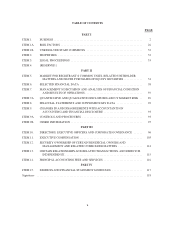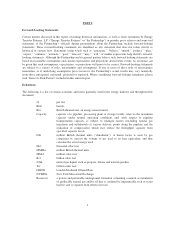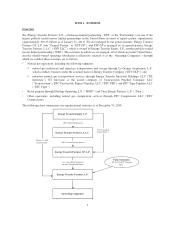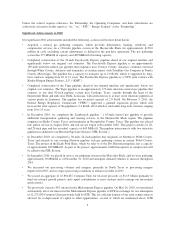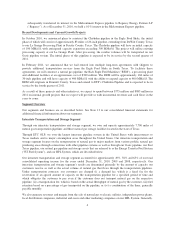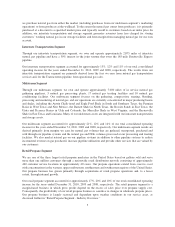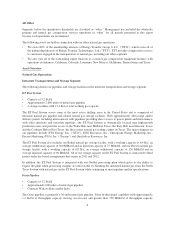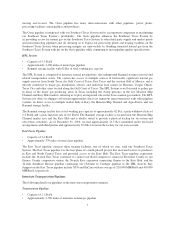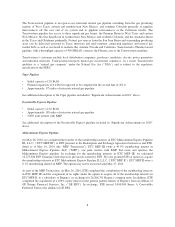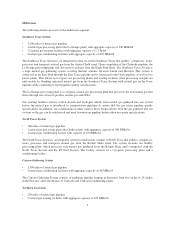Energy Transfer 2010 Annual Report Download - page 9
Download and view the complete annual report
Please find page 9 of the 2010 Energy Transfer annual report below. You can navigate through the pages in the report by either clicking on the pages listed below, or by using the keyword search tool below to find specific information within the annual report.moving east-to-west. The Oasis pipeline has many interconnections with other pipelines, power plants,
processing facilities, municipalities and producers.
The Oasis pipeline is integrated with our Southeast Texas System and is an important component to maximizing
our Southeast Texas System’s profitability. The Oasis pipeline enhances the Southeast Texas System by
(i) providing access for natural gas on the Southeast Texas System to other third party supply and market points
and interconnecting pipelines and (ii) allowing us to bypass our processing plants and treating facilities on the
Southeast Texas System when processing margins are unfavorable by blending untreated natural gas from the
Southeast Texas System with gas on the Oasis pipeline while continuing to meet pipeline quality specifications.
HPL System
• Capacity of 5.5 Bcf/d
• Approximately 4,100 miles of natural gas pipeline
• Bammel storage facility with 62 Bcf of total working gas capacity
The HPL System is comprised of intrastate natural gas pipelines, the underground Bammel storage reservoir and
related transportation assets. The system has access to multiple sources of historically significant natural gas
supply reserves from South Texas, the Gulf Coast of Texas, East Texas and the western Gulf of Mexico, and is
directly connected to major gas distribution, electric and industrial load centers in Houston, Corpus Christi,
Texas City and other cities located along the Gulf Coast of Texas. The HPL System is well situated to gather gas
in many of the major gas producing areas in Texas including the strong presence in the key Houston Ship
Channel and Katy Hub markets, allowing us to play an important role in the Texas natural gas markets. The HPL
System also offers its shippers off-system opportunities due to its numerous interconnections with other pipeline
systems, its direct access to multiple market hubs at Katy, the Houston Ship Channel and Agua Dulce, and our
Bammel storage facility.
The Bammel storage facility has a total working gas capacity of approximately 62 Bcf, a peak withdrawal rate of
1.3 Bcf/d and a peak injection rate of 0.6 Bcf/d. The Bammel storage facility is located near the Houston Ship
Channel market area and the Katy Hub and is ideally suited to provide a physical backup for on-system and
off-system customers. As of December 31, 2010, we had approximately 21.5 Bcf committed under fee-based
arrangements with third parties and approximately 39.8 Bcf stored in the facility for our own account.
East Texas Pipeline
• Capacity of 2.4 Bcf/d
• Approximately 370 miles of natural gas pipeline
The East Texas pipeline connects three treating facilities, one of which we own, with our Southeast Texas
System. The East Texas pipeline was the first phase of a multi-phased project that increased service to producers
in East and North Central Texas and provided access to the Katy Hub. The East Texas pipeline expansions
include the 36-inch East Texas extension to connect our Reed compressor station in Freestone County to our
Grimes County compressor station, the 36-inch Katy expansion connecting Grimes to the Katy Hub, and the
42-inch Southeast Bossier pipeline connecting our Cleburne to Carthage pipeline to the HPL System. Key
shippers on the East Texas pipeline include XTO and EnCana with an average of 520,000 MMBtu/d and 410,000
MMBtu/d, respectively.
Interstate Transportation Pipelines
The following details our pipelines in the interstate transportation segment.
Transwestern Pipeline
• Capacity of 2.1 Bcf/d
• Approximately 2,700 miles of interstate natural gas pipeline
7


